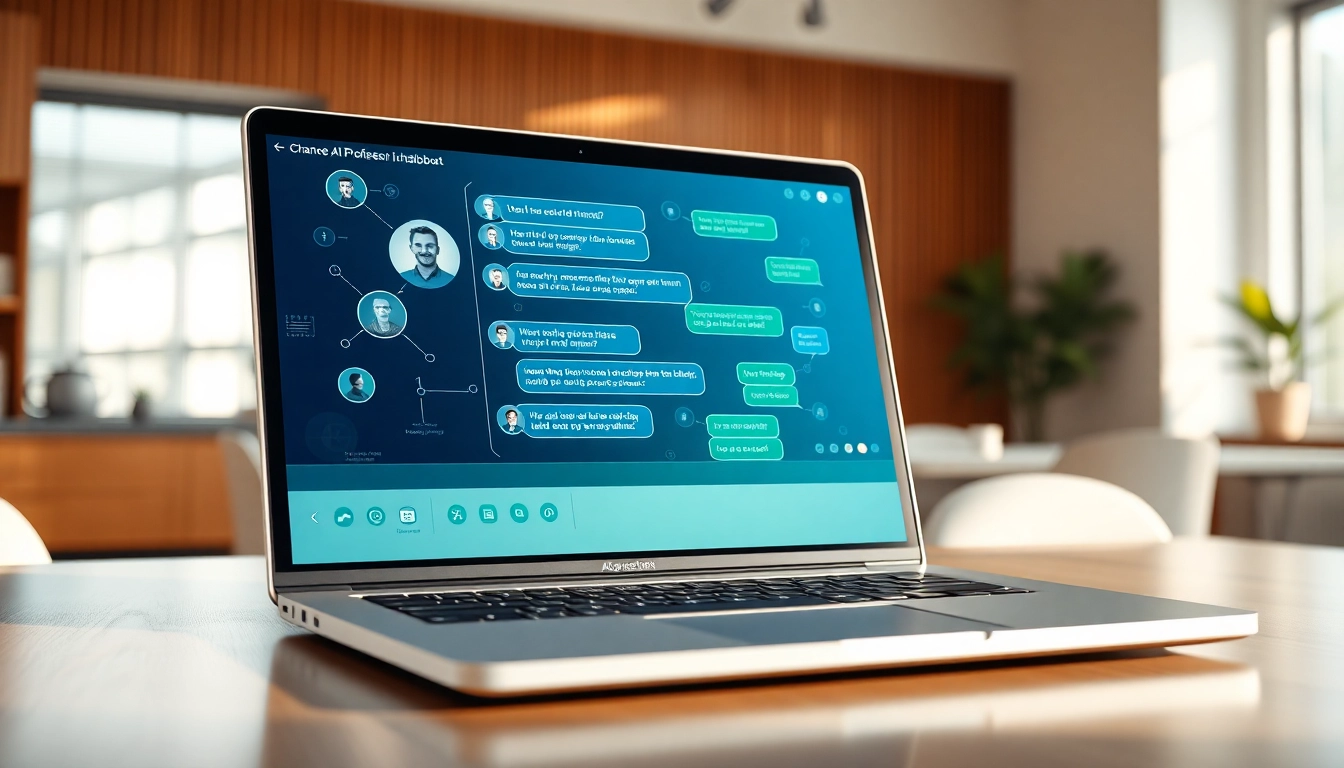Understanding AI Chatbots for Websites
In today’s fast-paced digital landscape, businesses are constantly seeking innovative ways to enhance customer engagement and streamline operations. This is where the AI chatbot for website comes into play. By leveraging artificial intelligence, these chatbots can engage users in real-time, answering queries, providing support, and even assisting in sales. The integration of chatbots into websites has revolutionized customer interactions, offering a seamless experience that can significantly improve conversion rates and customer satisfaction.
What is an AI Chatbot?
An AI chatbot is a software program that utilizes natural language processing (NLP) and machine learning algorithms to simulate human conversation. Unlike traditional chatbots, which rely on predefined scripts and keyword matching, AI chatbots learn from interactions over time, enabling them to understand context, intent, and even sentiment. This advanced capability allows them to generate more relevant responses and handle complex inquiries effectively, making them invaluable tools for businesses looking to enhance their online customer service.
How Does an AI Chatbot for Website Work?
The functioning of an AI chatbot on a website involves several key components, including:
- Natural Language Processing (NLP): NLP enables the chatbot to understand and interpret user inputs in a conversational manner. It breaks down the text into a format that the machine can comprehend.
- Machine Learning: This allows the chatbot to learn from past interactions, continuously improving its responses and accuracy.
- Backend Integration: Effective chatbots can integrate with existing databases or customer relationship management (CRM) systems, allowing them to pull personalized information, previous interactions, or even product recommendations.
- Response Generation: Based on the understanding derived from NLP and data, the chatbot formulates appropriate responses to user queries.
Ultimately, these components work together to create a responsive and intuitive conversational agent that enhances user interactions and drives engagement on your website.
Benefits of Implementing AI Chatbots
Integrating AI chatbots into your website can yield numerous benefits, including:
- 24/7 Availability: Unlike human agents, AI chatbots can operate around the clock, providing immediate responses to user inquiries at any time of the day or night.
- Cost Efficiency: Implementing chatbots can significantly reduce operational costs associated with customer service by minimizing the need for large customer support teams.
- Enhanced Customer Experience: With quick response times and personalized interactions, chatbots can greatly improve user satisfaction and foster loyalty.
- Increased Conversion Rates: By guiding customers through their purchasing journey and providing instant assistance, chatbots can help increase the chances of conversion.
Key Features of Effective AI Chatbots
Personalization and User Experience
One of the standout features of effective AI chatbots is their ability to offer personalized experiences. By utilizing user data and interaction history, chatbots can tailor conversations to individual users, providing relevant recommendations and support. This personal touch not only enhances user satisfaction but also increases engagement, as customers feel understood and valued. Developing segments based on user behavior and preferences allows for better-targeted outreach, ensuring that interactions are meaningful and relevant.
Integration Capabilities with Existing Systems
Effective AI chatbots should have robust integration capabilities, allowing them to connect seamlessly with existing software and platforms. This might include CRM systems, e-commerce platforms, or help desk solutions, which enhances their functionality and reach. For instance, a chatbot integrated with your CRM can access and utilize customer data to provide personalized responses. This capability not only improves efficiency but also streamlines internal processes and enhances the user experience.
Analytics and Performance Tracking
Analytics and performance tracking are crucial features for any effective AI chatbot. Businesses need to understand how users are interacting with the chatbot, which questions are most frequently asked, and where users may be encountering issues. Advanced analytics tools integrated into chatbots allow businesses to monitor engagement metrics, user satisfaction levels, and conversion rates, providing insights that can inform future improvements and ensure the chatbot is meeting its objectives.
Choosing the Right AI Chatbot for Your Business
Evaluating Your Business Needs
Before selecting an AI chatbot, it’s essential to evaluate your specific business needs. Consider the following factors:
- Customer Interaction Volume: Determine how often customers reach out for support or information. This will help you gauge the necessary response capabilities.
- Type of Inquiries: Analyze the common types of questions or issues customers face that the chatbot would need to address.
- Integration Requirements: Identify any existing systems the chatbot will need to interact with to function optimally.
- Budget Considerations: Establish a budget for initial implementation and ongoing maintenance, taking into account the potential ROI.
Comparing Top AI Chatbot Platforms
When it comes to selecting a chatbot platform, numerous options are available, each with its features and capabilities. Some of the top platforms to consider include:
- Dialogflow: Powered by Google, this platform provides powerful NLP capabilities and is particularly strong in integrating with other Google services.
- Chatfuel: Ideal for those looking to create a chatbot without extensive programming knowledge, Chatfuel offers a user-friendly interface.
- ManyChat: Well-suited for marketing purposes, ManyChat allows for the creation of bots on platforms like Facebook Messenger.
- Zendesk Chat: Great for businesses already using Zendesk, this option enhances customer support capabilities and integrates smoothly with existing workflows.
When weighing your options, consider factors such as ease of use, customer support availability, customization options, and pricing plans.
Budget Considerations for Implementation
Implementing an AI chatbot comes with various cost considerations. Initial costs could include development and installation, while ongoing costs might involve maintenance, updates, and analytics services. It’s essential to forecast the potential return on investment. Look for platforms that offer scalable pricing plans that align with your business’s growth, ensuring you get a solution that adapts to your needs. Furthermore, consider the long-term savings on customer service costs against the cost of implementation.
Best Practices for Deploying AI Chatbots
Training Your Chatbot for Optimal Performance
The success of an AI chatbot largely hinges on how well it has been trained. Training should encompass a vast range of user queries, including typical questions and complex issues. Utilize a diverse dataset to help the chatbot understand different linguistic styles and terminologies. Regular updates and retraining based on user interactions can significantly enhance the chatbot’s effectiveness, ensuring it remains relevant as your products or services evolve.
Maintaining Human Oversight in Conversations
While AI chatbots are powerful tools, they are not infallible. Maintaining human oversight in conversations can help bridge gaps in understanding and provide a safety net for complex interactions. Set up protocols for when to escalate issues to human agents, particularly in scenarios involving sensitive information or high-stakes decisions. This hybrid approach enhances the user experience, as customers feel reassured that assistance is accessible when needed.
Regularly Updating Content and Features
An AI chatbot is not a static entity; it requires regular updates to its content and features to remain effective. Monitor trends in customer inquiries and adjust the chatbot’s knowledge base accordingly. Introducing new features and enhancing existing ones based on user feedback will keep your chatbot relevant and valuable to customers. Regularly scheduled content reviews can greatly contribute to maintaining accuracy and ensuring your chatbot meets evolving user needs.
Measuring the Success of Your AI Chatbot
Key Performance Indicators to Monitor
Effectively measuring the success of an AI chatbot requires careful consideration of key performance indicators (KPIs). Common KPIs include:
- Response Time: Assess how quickly the chatbot can respond to queries. Short response times are critical for user satisfaction.
- Resolution Rate: This indicates the percentage of inquiries successfully resolved by the chatbot without human intervention.
- User Engagement: Monitor how many users interact with the chatbot and the length of those interactions to gauge engagement levels.
- Customer Satisfaction Scores: Use post-interaction surveys to gather feedback on user experiences and satisfaction.
Customer Feedback and Satisfaction Analysis
Collecting and analyzing customer feedback is vital for measuring the effectiveness of your chatbot. Customer satisfaction surveys and feedback forms can offer valuable insights into users’ experiences. Be open to criticism and utilize feedback to make iterative improvements. Regularly reviewing this feedback will help identify areas needing enhancement, leading to a more effective chatbot.
Iterative Improvement Strategies for Long-Term Success
To ensure the long-term success of your AI chatbot, adopt an iterative improvement approach. This involves continuously analyzing performance, implementing user feedback, and updating features. Establish periodic reviews to assess the chatbot’s impact on customer satisfaction and operational efficiency. Keep track of emerging trends in technology and customer service to stay ahead of the curve and regularly enhance the chatbot’s capabilities. By creating a culture of continuous improvement, you ensure your chatbot remains an asset to your business.













Leave a Reply